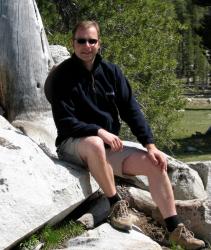|
NOV
8
2010
|
Martin Eisenhardt Ever wondered who is behind anonsvn.kde.org? Want to know what drives a person to provide that service to KDE for years and years? Martin Eisenhardt will tell you in this weeks behindkde's interview. As we speak he is setting up one of the first anongit.kde.org mirrors, which will be live later this week!
Ever wondered who is behind anonsvn.kde.org? Want to know what drives a person to provide that service to KDE for years and years? Martin Eisenhardt will tell you in this weeks behindkde's interview. As we speak he is setting up one of the first anongit.kde.org mirrors, which will be live later this week!
Can you give an introduction of yourself?Well, I am Martin Eisenhardt, thirty-something years old, married to my lovely wife Claudia. We are living in a small town called Lauf, which is near Nuremberg, Bavaria, Germany. I hold an advanced degree in Computer Science; my favorite pastimes are programming, reading, music, hiking, and photography.Can you tell us what you do for a living?Currently, I am working with Senacor Technologies, a medium-sized software consultancy that caters primarily to the financial industry (read: big banking and insurance companies), although we have some other big-time companies as clients. So, you could say that I earn my money by developing enterprisey software.Can you tell us what you do for KDE?For several years, I have been running one of the mirrors of KDE's Subversion repository. For those who want to know whose mirror is down again: It's anonsvn5.kde.org, also known as kde.mneisen.org.While I do no programming for KDE (at least not at the moment), I feel that this is a way to give back to KDE's great community. You are maintaining an anonsvn server for ages now, who pays for that and why such dedication?"Ages" does mean several years in my case, and it has always been a great pleasure and satisfaction to provide this service to KDE's developers. The server running my mirror is paid for by me; although the server is not dedicated to only serve anonsvn5.kde.org. Quite to the contrary, the server runs many services but still has resources unused, so initially I simply wanted to donate these unneeded resources to a good cause.Nowadays, when the server gets upgraded, I always keep in mind to set aside enough resources to allow for anonsvn running with more than acceptable performance. The dedication for providing a mirror to KDE is easy to explain: KDE has always provided me with a great desktop experience, so it is only natural for me to give something back. Of course, it is not possible to support each and every OSS project in existence, but I tackle that problem one project at a time ... :D How come when we mail you with a problem, you always react within very short time?Running an infrastructure service like a Subversion mirror for an active community of developers is something that I take seriously. For that reason - and apart from being mid-air, mountaineering or seriously sick - I always keep on eye on my inbox so that I can react in a timely manner.The coming months stuff will change due to the transition to git. Can you explain the changes and your role in it?I expect my role to change from a provider of a Subversion mirror to being the provider of an installation of gitolite, hosting all the git repositories of KDE's various parts, projects, and applications.On a side node: I am really looking forward to using git; I use it on a lot of my own projects, and I think it is a very good replacement for Subversion. What are the areas where KDE and its software really shines in your opinion?IMHO, KDE has several strong advantages:
Do you have a vision, like where do you want KDE in general to be in 5 years and sysadmin in particular?Five years is a very long time in software; just look back to 2005 and remember how things were back then. Therefore, I do not have a clear vision as such, but rather like to envision a path into the future.I believe and hope that KDE will continue to be on the leading edge of modern desktops, and that it keeps developing the kind of neat little (and bigger!) tools that I really like about KDE right now. In my expectation, the future looks great for KDE. |
